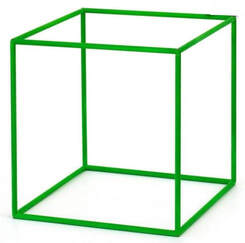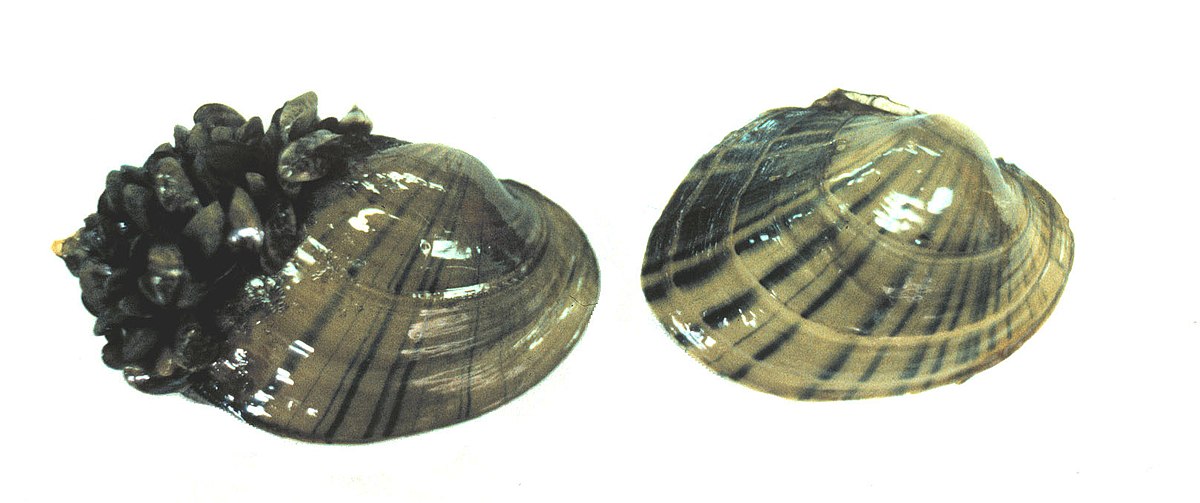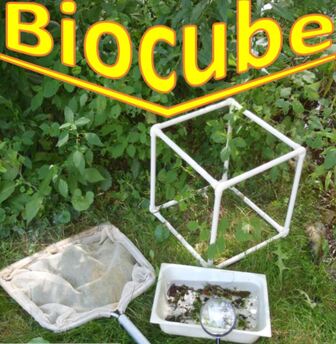
Biodiversity in a BioCube: Do You See Invasive Species?
By Erica Sprague
CLICK ON IMAGE TO DOWNLOAD A PRINTABLE VERSION OF THIS LESSON PLAN
We would greatly appreciate your feedback! Click here to complete a short survey telling us about your experience with this lesson plan.
By Erica Sprague
CLICK ON IMAGE TO DOWNLOAD A PRINTABLE VERSION OF THIS LESSON PLAN
We would greatly appreciate your feedback! Click here to complete a short survey telling us about your experience with this lesson plan.
Lesson Overview:
Biologists around the world are finding out that biodiversity is on the decline in many key areas. People do not always realize how biodiversity affects human survival and success. In some locations, biodiversity, or the differences in life, is declining in ecosystems where non-native and invasive species have been introduced. In this lesson, students will explore the biodiversity in one cubic foot near their classroom, create a food web for the cubic foot ecosystem, and then investigate the potential loss of biodiversity in this ecosystem due to invasive species that are already here (or expected to be here).
Grade Level: grades 6 - 8.
Sources Consulted:
Learning Objectives:
After the lesson, students will be able to…
Michigan Science Standards Addressed:
SEP: Science and Engineering Practices
List of Materials:
Room Arrangement or Special Needs
Students are grouped together for the activities and lab (3-4 students max).
New Vocabulary
Biodiversity: The differences in life
Non-Native Species: Species that have been introduced into an ecosystem that they have not historically been a part of (synonyms: alien species, nonindigenous species, introduced species)
Invasive Species: A non-native species in an ecosystem that may cause harm to the economy, the environment or human health.
Food Web: A system of interconnected and interrelated food chains
Producer: An organism that can make its own food
Consumer: An organism that must eat other organisms to obtain energy
Decomposer: An organism that breaks down dead and decaying organic matter as an energy source
5E Model Lesson Plan
Engage - Guiding Question: Do Invasive Species Affect Biodiversity in Ecosystems?
How many living things do you think there are on planet earth? Do we need every single one of them? Challenge students to think about how they depend on all living things, either directly or indirectly. If students do not know what biodiversity is, explain that it is the differences in living forms or types. Why might high biodiversity be better than low biodiversity? How could one new species in an ecosystem possibly reduce biodiversity?
A real-life example: when zebra mussels invaded the Great Lakes, many native mussels (which had been food for other animals in the ecosystem and also used economically for their shells) were displaced and became endangered or extinct in many places such as Lake St. Clair.
Here's a picture of zebra mussels practically “strangling” a native mussel:
Biologists around the world are finding out that biodiversity is on the decline in many key areas. People do not always realize how biodiversity affects human survival and success. In some locations, biodiversity, or the differences in life, is declining in ecosystems where non-native and invasive species have been introduced. In this lesson, students will explore the biodiversity in one cubic foot near their classroom, create a food web for the cubic foot ecosystem, and then investigate the potential loss of biodiversity in this ecosystem due to invasive species that are already here (or expected to be here).
Grade Level: grades 6 - 8.
Sources Consulted:
- What Makes a Species Invasive? NWF Article
- MSU: Non Natives 2nd Biggest Threat to Local and Global Diversity
- Invasive Species in Michigan Threatening Biodiversity
- Impacts of zebra mussels
- Why is Biodiversity Important (w/video at the end)
- Why is Biodiversity Important (short)
- BioCube Video
- How to Use Bio Cubes
- Biocube instructions (pdf)
- You’d Be Astounded To Learn… (Smithsonian Mag-Life in One Cubic Foot)
Learning Objectives:
After the lesson, students will be able to…
- Explain why biodiversity on earth is vital to human survival
- Study biodiversity in one cubic foot in a lab near the school
- Create a food web for the ecosystem observed in the cubic foot
- Explain how invasive species can affect ecosystems and potentially reduce biodiversity
Michigan Science Standards Addressed:
SEP: Science and Engineering Practices
- Planning and Carrying Out Investigations
- Analyzing and Interpreting Data
- MS-LS2-1 Analyze and interpret data to provide evidence for the effects of resource availability on organisms and populations of organisms in an ecosystem.
- MS-LS2-3 Develop a model to describe the cycling of matter and flow of energy among living and nonliving parts of an ecosystem.
- MS-LS2-4 Construct an argument supported by empirical evidence that changes to physical or biological components of an ecosystem affect populations.
- Cause and Effect
- Stability and Change
List of Materials:
- Computer access to links or printed articles.
- Biocubes (1 ft x 1 ft x 1 ft PVC cube frames)-one per class or one per group, depending on resources available
- Field Guides (insects, weeds, trees, etc.)
Room Arrangement or Special Needs
Students are grouped together for the activities and lab (3-4 students max).
New Vocabulary
Biodiversity: The differences in life
Non-Native Species: Species that have been introduced into an ecosystem that they have not historically been a part of (synonyms: alien species, nonindigenous species, introduced species)
Invasive Species: A non-native species in an ecosystem that may cause harm to the economy, the environment or human health.
Food Web: A system of interconnected and interrelated food chains
Producer: An organism that can make its own food
Consumer: An organism that must eat other organisms to obtain energy
Decomposer: An organism that breaks down dead and decaying organic matter as an energy source
5E Model Lesson Plan
Engage - Guiding Question: Do Invasive Species Affect Biodiversity in Ecosystems?
How many living things do you think there are on planet earth? Do we need every single one of them? Challenge students to think about how they depend on all living things, either directly or indirectly. If students do not know what biodiversity is, explain that it is the differences in living forms or types. Why might high biodiversity be better than low biodiversity? How could one new species in an ecosystem possibly reduce biodiversity?
A real-life example: when zebra mussels invaded the Great Lakes, many native mussels (which had been food for other animals in the ecosystem and also used economically for their shells) were displaced and became endangered or extinct in many places such as Lake St. Clair.
Here's a picture of zebra mussels practically “strangling” a native mussel:

What are other ways that an animal like the zebra mussel might endanger other wildlife and people?
Explore - Activities
Explain -Biodiversity BioCube Lab
Explore - Activities
- What Is An Ecosystem?: Students will explore the parts of an ecosystem to see how different organisms depend on one another, either directly or indirectly by studying a food web
- See Teacher Resource at the end of the lesson document
- Why Is Biodiversity Important?:
- Article 1: Why is Biodiversity Important (w/video at the end)
- Article 2: Why is Biodiversity Important (short)
- Students should be able to compile a list of how humans depend on biodiversity. This can be done in pairs, small groups or as a class discussion
- Life in One Cubic Foot:
- Intro to the BioCube Lab-Students will be studying the biodiversity in their own school yard
- BioCube Video (1:40 min)
- Extra: How to Use Bio Cubes (building and connecting with Smithsonian)
- Extra Reading: You’d Be Astounded To Learn… (Smithsonian Mag-Life in One Cubic Foot)
Explain -Biodiversity BioCube Lab
- Life in One Cubic Foot Lab
- Students will complete the biocube lab in small groups to assess the biodiversity in the area

photo source: https://albany.kidsoutandabout.com/content/biocube
Elaborate - Biodiversity, Food Webs and Invasive Species
Evaluate - Apply Knowledge
- Location: After constructing the biocube (or being given it by the teacher), a group of students will place their biocube somewhere in the outside environment and observe what organisms are within the cube. If the cube can be placed somewhere where the edges can be buried underneath the surface, then organisms in the soil (or water) that are within the cube volume can be sampled and examined. Some recommendations for the use of biocubes recommend looking for a place where one type of habitat meets another (e.g., in the photo, a grassy area next to a bushy area, so both habitats and the soil can be sampled); however, even a “plain” grassy area or concrete surface could be examined. You might be surprised at how many creatures you will find in such simple habitats! If teachers can choose a location that is diverse AND may contain (or have the potential to contain) a non-native or invasive species, that would be beneficial for teaching about invasive species!
- Time: students can look at this cube over a period of time, depending on the location and the time constraints of the class. The longer the cube is observed, the greater the number of living organisms will be noted. If the class is observing one cube, a game cam can be used to monitor the cube outside of class time.
- Closer observation: Depending on how closely and how thoroughly you wish to examine and count the cube’s occupants, students might collect organisms to examine more closely in the classroom. This might include flower or leaf cuttings, small insects, spiders, worms, and so on.
- See Lab Document at the end of the lesson under teacher resources
Elaborate - Biodiversity, Food Webs and Invasive Species
- Create a Food Web: Students will construct a food web, to the best of their ability, from research, field guides, etc. based on the organisms in the biocube
- Note all producers, consumers, decomposers, etc
- Note any non-native or invasive species that may have been documented
- Many may be plants such as garlic mustard, star thistle, purple loosestrife.
Evaluate - Apply Knowledge
- Remind students of the guiding question Do Invasive Species Affect Biodiversity in Ecosystems?
- Students will be asked to take their original food web and add in likely non-native or invasive species that could be a part of the ecosystem they observed.
- Note the non-native/invasive species role (consumer, producer, decomposer)
- What will eat it?
- What eats it?
- What food chains within the ecosystem are directly affected by this new species?
- What native species are at the greatest risk of being eliminated from this ecosystem as a result of the new species?
- Essay Question: Using the articles provided to you, your experiences in lab and your biocube food web as references, explain how non-native and invasive species can have an effect on ecosystem biodiversity and why people should be concerned with a loss of biodiversity.

New lesson plan ideas are welcome and will be uploaded as they are received and approved.
Instructions for submitting lesson plans for:
About invasive species,
About science and science careers
For information about submitting new lesson plans, please contact jchadde(at)mtu.edu
Lesson plan ideas from other web sites:
From Pennsylvania Sea Grant: 10 lesson plans about interactions of invasive species, biodiversity, and climate change
Creation of the above page of educational resources was funded in part by the Michigan Invasive Species Grant Program through the Departments of Natural Resources, Environmental Quality, and Agricultural and Rural Development.
This material is also based upon work supported by the National Science Foundation under Grant No. 1614187.
Any opinions, findings, and conclusions or recommendations expressed in this material are those of the authors and do not necessarily reflect the views of the National Science Foundation.
Instructions for submitting lesson plans for:
About invasive species,
About science and science careers
For information about submitting new lesson plans, please contact jchadde(at)mtu.edu
Lesson plan ideas from other web sites:
From Pennsylvania Sea Grant: 10 lesson plans about interactions of invasive species, biodiversity, and climate change
Creation of the above page of educational resources was funded in part by the Michigan Invasive Species Grant Program through the Departments of Natural Resources, Environmental Quality, and Agricultural and Rural Development.
This material is also based upon work supported by the National Science Foundation under Grant No. 1614187.
Any opinions, findings, and conclusions or recommendations expressed in this material are those of the authors and do not necessarily reflect the views of the National Science Foundation.